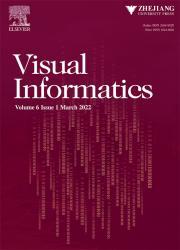CineFolio: Cinematography-guided camera planning for immersive narrative visualization
IF 3.8
3区 计算机科学
Q2 COMPUTER SCIENCE, INFORMATION SYSTEMS
引用次数: 0
Abstract
Narrative visualization facilitates data presentation and communicates insights, while virtual reality can further enhance immersive and engaging experiences. The combination of these two research interests shows the potential to revolutionize the way data is presented and understood. Within the realm of narrative visualization, empirical evidence has particularly highlighted the importance of camera planning. However, existing works primarily rely on user-intensive manipulation of the camera, with little effort put into automating the process. To fill the gap, this paper proposes CineFolio, a semi-automated camera planning method to reduce manual effort and enhance user experience in immersive narrative visualization. CineFolio combines cinematic theories with graphics criteria, considering both information delivery and aesthetic enjoyment to ensure a comfortable and engaging experience. Specifically, we parametrize the considerations into optimizable camera properties and solve it as a constraint satisfaction problem (CSP) to realize common camera types for narrative visualization, namely overview camera for absorbing the scale, focus camera for detailed views, moving camera for animated transitions, and user-controlled camera allowing users to provide inputs to camera planning. We demonstrate the feasibility of our approach with cases of various data and chart types. To further evaluate our approach, we conducted a within-subject user study, comparing our automated method with manual camera control, and the results confirm both effectiveness of the guided navigation and expressiveness of the cinematic design for narrative visualization.
CineFolio:沉浸式叙事可视化的电影指导相机规划
叙事可视化有助于数据呈现和交流见解,而虚拟现实可以进一步增强身临其境和引人入胜的体验。这两个研究兴趣的结合显示了数据呈现和理解方式的革命性潜力。在叙事可视化领域,经验证据特别强调了相机规划的重要性。然而,现有的作品主要依赖于用户对相机的密集操作,很少在自动化过程中投入精力。为了填补这一空白,本文提出了CineFolio,一种半自动化的摄像机规划方法,以减少人工工作量,增强沉浸式叙事可视化中的用户体验。CineFolio将电影理论与图形标准相结合,考虑到信息传递和审美享受,以确保舒适和引人入胜的体验。具体来说,我们将这些考虑参数化为可优化的摄像机属性,并将其作为约束满足问题(CSP)来解决,以实现用于叙事可视化的常见摄像机类型,即用于吸收尺度的全景摄像机,用于详细视图的焦点摄像机,用于动画过渡的移动摄像机,以及允许用户为摄像机规划提供输入的用户控制摄像机。我们用各种数据和图表类型的案例来证明我们的方法的可行性。为了进一步评估我们的方法,我们进行了一项主题内用户研究,将我们的自动化方法与手动相机控制方法进行了比较,结果证实了引导导航的有效性和电影设计对叙事可视化的表现力。
本文章由计算机程序翻译,如有差异,请以英文原文为准。
求助全文
约1分钟内获得全文
求助全文
来源期刊

Visual Informatics
Computer Science-Computer Graphics and Computer-Aided Design
CiteScore
6.70
自引率
3.30%
发文量
33
审稿时长
79 days
 求助内容:
求助内容: 应助结果提醒方式:
应助结果提醒方式:


